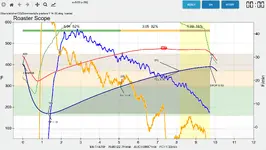Good Day,
To date I have been roasting to the start of 2nd crack. I have noticed that if I try and shorten my DTR I get underdeveloped coffee, noticeable by taste. CGA's present.
My question is, how do I approach a light roast while maintaining a fully developed roast.
Hotter or colder charge temp relative to my standard roast?
Longer or shorter period in the first and or second phase? etc
I am concerned that if I drop at FC or soon there after I will be well underdeveloped.
Many thanks..........
To date I have been roasting to the start of 2nd crack. I have noticed that if I try and shorten my DTR I get underdeveloped coffee, noticeable by taste. CGA's present.
My question is, how do I approach a light roast while maintaining a fully developed roast.
Hotter or colder charge temp relative to my standard roast?
Longer or shorter period in the first and or second phase? etc
I am concerned that if I drop at FC or soon there after I will be well underdeveloped.
Many thanks..........

